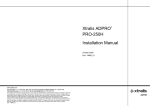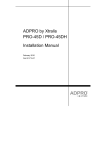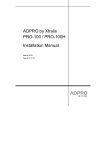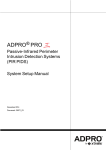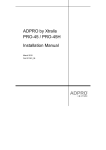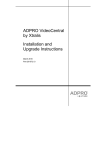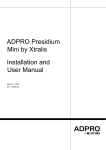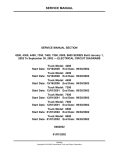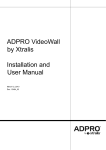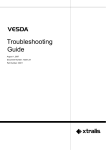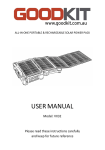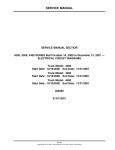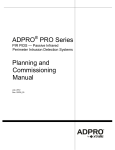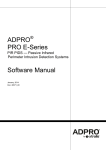Download PRO 18 Series Installation Manual
Transcript
PRO 18 Series Installation Manual May 2007 Part 201362.05 PRO 18 Series Installation Manual Disclaimer The contents of this document are provided on an "as is" basis. No representation or warranty (either express or implied) is made as to the completeness, accuracy or reliability of the contents of this document. The manufacturer reserves the right to change designs or specifications without obligation and without further notice. Except as otherwise provided, all warranties, express or implied, including without limitation any implied warranties of merchantability and fitness for a particular purpose are expressly excluded. Intellectual Property and Copyright The contents of this document are provided on an "as is" basis. No representation or warranty (either express or implied) is made as to the completeness, accuracy or reliability of the contents of this document. The manufacturer reserves the right to change designs or specifications without obligation and without further notice. Except as otherwise provided, all warranties, express or implied, including without limitation any implied warranties of merchantability and fitness for a particular purpose are expressly excluded. General Warning This product must only be installed, configured and used strictly in accordance with the General Terms and Conditions, User Manual and product documents available from Xtralis. All proper health and safety precautions must be taken during the installation, commissioning and maintenance of the product. The system should not be connected to a power source until all the components have been installed. Proper safety precautions must be taken during tests and maintenance of the products when these are still connected to the power source. Failure to do so or tampering with the electronics inside the products can result in an electric shock causing injury or death and may cause equipment damage. Xtralis is not responsible and cannot be held accountable for any liability that may arise due to improper use of the equipment and/or failure to take proper precautions. Only persons trained through an Xtralis accredited training course can install, test and maintain the system. Liability You agree to install, configure and use the products strictly in accordance with the User Manual and product documents available from Xtralis. Xtralis is not liable to you or any other person for incidental, indirect, or consequential loss, expense or damages of any kind including without limitation, loss of business, loss of profits or loss of data arising out of your use of the products. Without limiting this general disclaimer the following specific warnings and disclaimers also apply: Fitness for Purpose You agree that you have been provided with a reasonable opportunity to appraise the products and have made your own independent assessment of the fitness or suitability of the products for your purpose. You acknowledge that you have not relied on any oral or written information, representation or advice given by or on behalf of Xtralis or its representatives. Total Liability To the fullest extent permitted by law that any limitation or exclusion cannot apply, the total liability of Xtralis in relation to the products is limited to: (i) in the case of services, the cost of having the services supplied again; or (ii) in the case of goods, the lowest cost of replacing the goods, acquiring equivalent goods or having the goods repaired. Indemnification You agree to fully indemnify and hold Xtralis harmless for any claim, cost, demand or damage (including legal costs on a full indemnity basis) incurred or which may be incurred arising from your use of the products. Miscellaneous If any provision outlined above is found to be invalid or unenforceable by a court of law, such invalidity or unenforceability will not affect the remainder which will continue in full force and effect. All rights not expressly granted are reserved. Doc 10650_05 i PRO 18 Series Installation Manual Document Conventions The following typographic conventions are used in this document. Convention Bold Italics Description Used to denote: emphasis Used for names of menus, menu options, toolbar buttons Used to denote: references to other parts of this document or other documents. Used for the result of an action The following icons are used in this document Convention Description Caution: This icon is used to indicate that there is a danger to equipment. The danger could be loss of data, physical damage, or permanent corruption of configuration details. Warning: This icon is used to indicate that there is a danger of electric shock. This may lead to death or permanent injury. Warning: This icon is used to indicate that there is a danger of inhaling dangerous substances. This may lead to death or permanent injury. Tradename statement ADPRO is a registered trademark of Xtralis AG Pty Ltd. Lightning or Related Voltage Surges Equipment malfunction caused by lightning or related voltage surges is specifically exempted from the warranty conditions. Xtralis AG Pty Ltd reserves the right as to final determination of whether or not an equipment malfunction was caused by lightning or related voltage surges. Contact Us The Americas +1 781 740 2223 Asia +852 2297 2438 Australia and New Zealand +61 3 9936 7000 Continental Europe +41 55 285 99 99 UK and the Middle East +44 1442 242 330 www.xtralis.com/adpro Doc 10650_05 PRO 18 Series Installation Manual Overview This manual describes the PRO 18 series of detectors, which includes the following models: • PRO 18 • PRO 18H • PRO 18W • PRO 18WH The PRO 18 series of detectors are highly sensitive passive infrared detectors with wide angle, volumetric differential fields of view, designed for detection outdoors. They incorporate microprocessor controlled signal processing, including signal shape analysis, adaptive threshold level by feedback of environmental effects, temperature compensation and rejection of disturbance signals. Sensitivity adjustments are done with DIP switches for each individual unit, to alter the required detection range in order to adapt to the specific needs of an installation. In addition to the hardware settings, adjustments can be made in a two way communication mode and signals displayed on a PC screen by using the optional installation software and RS485 communication interface module. Doc 10650_05 PRO 18 Series Installation Manual Contents 1.0 Mounting and Installation.......................................................................... 1 2.0 Hardware / Software Mode of Operation ................................................. 1 3.0 Connecting the PRO 18 .............................................................................. 2 3.1 Alarm Signalling ..................................................................... 2 3.2 Cover Tamper Switch............................................................. 2 3.3 Electronics Supply ................................................................. 2 3.4 Anti-Tamper Output ............................................................... 2 4.0 Field of View................................................................................................ 3 4.1 PRO 18..................................................................................... 3 4.2 PRO 18H .................................................................................. 3 4.3 PRO 18W ................................................................................. 3 4.4 PRO 18WH............................................................................... 3 5.0 Alignment..................................................................................................... 3 5.1 Typical Vertical Alignment .................................................... 4 5.1.1 PRO 18 for a required detection range of 24 m............. 4 5.1.2 PRO 18H for a required detection range of 30 m .......... 4 5.1.3 PRO 18W for a required detection range of 21 m ......... 5 5.1.4 PRO 18WH for a required detection range of 27 m....... 5 5.2 Typical Horizontal Alignment................................................ 6 5.2.1 PRO 18 .......................................................................... 6 5.2.2 PRO 18H........................................................................ 6 5.2.3 PRO 18W ....................................................................... 7 5.2.4 PRO 18WH .................................................................... 8 6.0 Sensitivity Settings ...................................................................................... 9 7.0 Adaptive Threshold Discrimination (ATD) .............................................. 9 8.0 Pulse Count................................................................................................ 10 9.0 Test ............................................................................................................. 11 10.0 Anti Tamper Feature ................................................................................ 11 11.0 LED ............................................................................................................ 12 12.0 Alarm Management .................................................................................. 13 13.0 Alarm Time................................................................................................ 13 14.0 Internal Temperature Compensation...................................................... 13 Doc 10650_05 i PRO 18 Series Installation Manual 15.0 Internal Heater (PRO 18H and PRO 18WH only)................................. 13 16.0 External Sensitivity Adjustment via RS485 Data Bus ........................... 14 17.0 Signal Processing....................................................................................... 14 18.0 Accessories ................................................................................................. 14 18.1 Interface Module IF 485B and Installation Software ......... 14 18.2 Cordless Walk Tester CT 45................................................ 16 18.2.1 Receiver ....................................................................... 16 18.2.2 Transmitter ................................................................... 17 18.3 Pole Mount Hardware ZA P-L1............................................ 17 19.0 Maintenance .............................................................................................. 18 20.0 General Comment on the PRO 18 ........................................................... 18 21.0 Wiring the Alarm Outputs ....................................................................... 20 22.0 Specifications ............................................................................................. 21 22.1 Mechanical Dimensions ...................................................... 23 Annex 1: Electronic Board and Terminal Block ............................................... 24 Annex 2: Two Way Communication RS485....................................................... 26 Annex 3: Installation Software............................................................................ 27 Doc 10650_05 PRO 18 Series Installation Manual 1.0 Mounting and Installation The mounting structure should be stiff enough and resistant to significant deflections in windy conditions. Movement of the PRO 18 caused by vibrations or other movements will result in swings of the field of view covered by the PRO 18 and could cause disturbance signals. These unwanted signals may lead to an increase of the alarm threshold level, which reduces the detection probability, or in certain cases can lead to unwanted alarms. The PRO 18 is supplied with a bracket suitable for wall mounting. A separate attachment (ZA P-L1) is available for mounting the detector on a pole, refer to section 18.3. CAUTION: It is very important that the cover of the PRO 18 is securely tightened. It must be tightened with the two screws to the point where it cannot be closed further with reasonable force. There will then be hardly any gap between the cover and the bottom part of the housing (considerably less than 1 mm). The cable entry assembly should not be changed without authorisation by the manufacturer. It is specifically designed to allow air entry and exit so that the inside of the PRO 18 is always at atmospheric pressure. This prevents moisture being sucked into the PRO 18 by a drop in internal pressure, likely to happen when rainfall rapidly cools down a unit warmed up in the sun. The nut on the cable entry assembly should be tightened to clamp the cable in place with the nylon grip. If the cable diameter is too small to be held by the grip, insulation tape should be wound around the cable to increase the outside diameter to a suitable size. 2.0 Hardware / Software Mode of Operation The PRO detectors can be operated in two modes of operation: • Hardware mode: The configuration and operation is managed by DIP switches on the PRO detectors. This particularly applies to the Sensitivity Settings. Note that some configuration changes can only be made through the installation software. Doc 10650_05 1 PRO 18 Series Installation Manual • 3.0 Software mode: Through the installation software and an RS485 connection, the configuration and operation is managed through software settings. This can be done proactively, or setup using the software and then disconnected from the RS485 bus. The detectors store their configuration locally. Connecting the PRO 18 For the definition of the connector board and terminal block refer to Annex 1: Electronic Board and Terminal Block for details. 3.1 Alarm Signalling There are two types of alarm signalling from the PRO 18: • one SPST potential-free relay contact • an RS485 two way communication link (refer to Annex 2: Two Way Communication RS 485) With the factory default setting, the relay contact opens on alarm. The output logic and function can be changed using the installation software. During turn-on time, the relay output is in the alarm state. 3.2 Cover Tamper Switch To detect attempts to open the PRO 18, a tamper switch is fitted on the cover. Its contact opens when the cover is opened and it should be connected in series with the normally closed relay contact. 3.3 Electronics Supply The PRO 18 can operate on either a 10.5 – 30 VDC or 24 VAC supply. If using a DC supply, ensure that polarity is correct when connecting power to the electronic circuit. Protective circuitry will withstand a short period of reversed polarity, but damage will result if this is not corrected quickly. 3.4 Anti-Tamper Output To detect if the PRO 18 has been moved, a movement detection sensor is located in the unit. If the PRO 18 is moved, the open collector transistor will signal. The transistor is open circuit in its default non-tamper state. Doc 10650_05 2 PRO 18 Series Installation Manual 4.0 4.1 Field of View PRO 18 The PRO 18 has a volumetric 50° angle of detection, with differential detection areas and a nominal range of 24 m. 4.2 PRO 18H The PRO 18H has a volumetric 50° angle of detection, with differential detection areas and a nominal range of 30 m. 4.3 PRO 18W The PRO 18W has a volumetric 90° angle of detection, with differential detection areas and a nominal range of 21 m. 4.4 PRO 18WH The PRO 18WH has a volumetric 90° angle of detection, with differential detection areas and a nominal range of 27 m. 5.0 Alignment The detection range of a PIR detector is not limited but a function of size, speed and temperature contrast of a target against its background. The PRO 18 should be aligned so that a natural or artificial background at the end of the range terminates the field of view. Vertical alignment is optimal when the upper edge of the field of view is at 1.5 to 2.5 m above ground at the end of the required detection range, provided that the field of view is properly terminated. Alignment can be done visually by looking along the groove on the top of the detector. This line of sight corresponds to the upper edge and centre of the detection pattern. Where the detection range has to be limited, a terminating screen can be used to avoid detection of targets beyond the wanted range. Note: Adverse environmental conditions may reduce the maximum detection range. Doc 10650_05 3 PRO 18 Series Installation Manual 5.1 Typical Vertical Alignment 5.1.1 PRO 18 for a required detection range of 24 m The PRO 18 should be aligned vertically so that at least the lower half of a person standing upright at the maximum required range will be within the field of view (refer to Figure 1 - Side view of PRO 18 below). 4m 3m 2m 1.5 m 1m 0 1 24 m Figure 1 - Side view of PRO 18 5.1.2 PRO 18H for a required detection range of 30 m The PRO 18H should be aligned vertically so that at least the lower half of a person standing upright at the maximum required range will be within the field of view (refer to Figure 2 - Side view of PRO 18H below). 4m 3m 2m 1.5 m 1m 0 1 30 m Figure 2 - Side view of PRO 18H Doc 10650_05 4 PRO 18 Series Installation Manual 5.1.3 PRO 18W for a required detection range of 21 m The PRO 18W should be aligned vertically so that at least the lower half of a person standing upright at the maximum required range will be within the field of view (refer to Figure 3 - Side view of PRO 18W below). Figure 3 - Side view of PRO 18W 5.1.4 PRO 18WH for a required detection range of 27 m The PRO 18WH should be aligned vertically so that at least the lower half of a person standing upright at the maximum required range will be within the field of view (refer to Figure 4 - Side view of PRO 18WH below). Figure 4 - Side view of PRO 18WH Doc 10650_05 5 PRO 18 Series Installation Manual 5.2 5.2.1 Typical Horizontal Alignment PRO 18 Horizontal alignment should be done to avoid unwanted signals being generated by targets (branches, bushes, fences) likely to be moved by wind (refer to Figure 5 - Top view of PRO 18 below). Movement within the field of view will reduce the sensitivity of the PRO 18 by increasing the alarm threshold level and may lead to unwanted alarms. 10 m 5m 50o 0 5m 10 m 0 5m 10 m 15 m 20 m 25 m Figure 5 - Top view of PRO 18 5.2.2 PRO 18H Horizontal alignment should be done to avoid unwanted signals being generated by targets (branches, bushes, fences) likely to be moved by wind (refer to Figure 6 - Top view of PRO 18H below). Movement within the field of view will reduce the sensitivity of the PRO 18H by increasing the alarm threshold level and may lead to unwanted alarms. Doc 10650_05 6 PRO 18 Series Installation Manual 10 m 5m 50o 0 5m 10 m 0 5m 10 m 15 m 20 m 25 m 30 m Figure 6 - Top view of PRO 18H 5.2.3 PRO 18W Horizontal alignment should be done to avoid unwanted signals being generated by targets (branches, bushes, fences) likely to be moved by wind (refer to Figure 7 - Top view of PRO 18W below). Movement within the field of view will reduce the sensitivity of the PRO 18W by increasing the alarm threshold level and may lead to unwanted alarms. Figure 7 - Top view of PRO 18W Doc 10650_05 7 PRO 18 Series Installation Manual 5.2.4 PRO 18WH Horizontal alignment should be done to avoid unwanted signals being generated by targets (branches, bushes, fences) likely to be moved by wind (refer to Figure 8 - Top view of PRO 18WH below). Movement within the field of view will reduce the sensitivity of the PRO 18WH by increasing the alarm threshold level and may lead to unwanted alarms. Figure 8 - Top view of PRO 18WH Note: The detection patterns of Figures 1 to 8 are for illustration of the volumetric coverage of the detectors. Actual detection zones depend on the mounting height and exact alignment. CAUTION: When walk testing the unit, the threshold level will increase as a result of the signal generated by the target and decrease exponentially in time after the event. To make sure that original sensitivity is reached, wait at least for three minutes between each crossing or disable the Adaptive Threshold Discrimination (ATD) function by setting DIP switch 3 to “off”. Doc 10650_05 8 PRO 18 Series Installation Manual If the Installation software is used for monitored walk tests and DIP switches 1 and 2 are set to software settings (on – on), the threshold level can be kept to its nominal value by changing the configuration of the ATD for this test. 6.0 Sensitivity Settings The various settings of the PRO 18 are made by means of multiple DIP switches on the connector board. The DIP switches 1 and 2 are for sensitivity setting, depending on the required detection performance. If the maximum required range is less than the nominal range of the detector, it is recommended to reduce the overall sensitivity to reduce nuisance alarms. (*) Switch 1 and 2 Overall Sensitivity off – off 40% off – on 75% on – off 100% (*) on – on Software Settings 20% … 140% (**) Factory Setting. (**) With DIP switches 1 and 2 both set to “on”, the overall sensitivity is 100% factory setting but can be changed with the installation software. If the sensitivity is adjusted with the installation software, the programmed value will remain active following a power off. Operation of the PRO 18 with overall sensitivity set to more than 100% is not recommended in outdoor applications as the nuisance alarm rate could increase significantly. 7.0 Adaptive Threshold Discrimination (ATD) The background noise is constantly averaged and used to adjust the threshold levels for the alarm. This special feature reduces the probability of nuisance alarms caused by wind, moving vegetation or objects that have a thermal contrast, although usually weaker than that of a person. Doc 10650_05 9 PRO 18 Series Installation Manual Each signal exceeding a certain minimum value will activate the ATD and increase the threshold levels, depending on its strength. The time constants for increase and decrease are chosen in a way to adapt to gradual changes. Signals generated by a person moving within the specified speed range, however, are fast enough for detection. Repeated movement of any kind within the field of view is therefore activating the ATD, reducing the overall sensitivity. This has to be noted particularly when walk testing the PRO 18 following installation. DIP switch 3 is used to activate or deactivate the ATD. (*) Switch 3 ATD off off (*) on on (**) Operation of the PRO 18 in this mode is possible but not recommended in outdoor applications, as the nuisance alarm rate could increase significantly as a result of turbulence. (**) Factory Setting. Note: When walk testing the unit, the threshold level will increase as a result of the signal generated by the target and decrease exponentially in time after the event. To make sure that original sensitivity is reached, wait for at least three minutes between each crossing or disable the ATD function by setting DIP switch 3 to “off“. If the Installation software is used for monitored walk tests and DIP switches 1 and 2 are set to software settings (on – on), the threshold level can be kept to its nominal value by changing the configuration of the ATD to “off“ for this test. 8.0 Pulse Count DIP switch 4 is used to set a pulse count delay for the alarm activation. This means that the alarm output is only activated after a pre-set number of pulses having reached the alarm criteria within a certain period of time. If DIP switch 4 is set to “on” the pulse count delay is 3. The programmed setting adds the defined number of pulses to the one pulse required without pulse count (e.g. pulse count 3 results in 1 + 3 = 4 pulses for alarm). Doc 10650_05 10 PRO 18 Series Installation Manual If software settings are used (DIP switches 1 and 2 need both to be set to “on”) the pulse count delay can be programmed to any value between 0 - 10. (*) Switch 4 Pulse Count off off on on (*) Factory Setting 3. 9.0 Test When doing a walk test using the CT 45 (refer to section 18.2), in HW mode DIP switch 5 must be set to “on“ or when operating the detector in SW mode the “test” mode must be set to “on“. After the walk test the “test” mode must be switched “off“. Important: The transmitter CT 45-T of the cordless installation tester has to be placed within the housing with the detector cover closed and securely tightened. The antenna of the transmitter must be placed straight in the detector housing. (*) Switch 5 Test off off (*) on on Factory Setting. 10.0 Anti Tamper Feature The PRO 18 is equipped with sophisticated protection against tampering. It detects misalignment of a detector from its original position, defined during installation and commissioning. A change of the detector position generates a permanent alarm until the detector’s alignment is back in its original position or until the position has purposely been reset. When using the alarm management with RS485 communication a tamper alarm will be identified separately. The transistor and/or relay may be configured via software to activate. By default, the transistor only activates for a tamper. After the turn-on time of typically 60 seconds from power on, the detector determines and stores its alignment position (only with the detector cover closed). Doc 10650_05 11 PRO 18 Series Installation Manual After opening and closing the cover with the unit powered on, the detector determines its alignment position and stores the position value after five minutes again without having the detector in permanent alarm state. During this time the anti tamper sensor can be reset with a power off-on. When using the PRO software the anti tamper sensor can be reset by means of setting the tamper reset function in the setting window. During normal operation, resetting the anti tamper sensor after the detector’s position has been changed, can be done either remotely with the PRO program (takes app. 10 seconds) or a power off-on (60 seconds). Hardware Mode When operating the detector in the HW mode, the anti vandal function is activated by setting DIP switch 6 to “on“. (*) Switch 6 Anti Tamper Feature off off on on (*) Factory Setting. Software Mode Operating the detector in the SW mode, the anti tamper function is activated by means of setting of the corresponding parameter in the settings of the PRO programs to “on“. By default, the anti-tamper function is enabled. 11.0 LED The electronic board is fitted with a dual LED, which has a red and green colour side. This can be monitored during installation while the cover is open. • • The red LED indicates whether the detector is in alarm state The green LED flashing at 2 Hz frequency indicates the detector ready state. During the turn-on time, the red LED is on. Doc 10650_05 12 PRO 18 Series Installation Manual 12.0 Alarm Management The PRO 18 features an alarm management function over RS485 communication. All the detectors connected to the same data bus provide all the information relevant to an alarm in a two-byte string. For further information please contact the manufacturer. 13.0 Alarm Time Alarm time and count per event is determined by the duration of the detected event and depends on the shape and amplitude of the alarm signal. Individual alarm pulses have a minimum time of approximately 2.5 s. 14.0 Internal Temperature Compensation The PRO 18 is detecting radiation differences of a target against its background. In the course of the day and year the contrast of a person will vary considerably and affect the signal strength. To compensate for this contrast variation, the PRO 18 has internal temperature compensation with maximum sensitivity at approximately 30°C (where the contrast of a human target is weakest) and gradual reduction at higher and lower temperatures. CAUTION: When installing a unit the internal temperature may take up to 30 minutes or more to stabilise to the actual external temperature. Sufficient time should be given to the PRO 18 to reach the correct internal temperature and sensitivity before performing walk tests. During the initial period of operation it is strongly recommended that walk tests are repeated and signals monitored under various weather conditions, such as high and low temperatures, wind, fog, snow, rain etc. to obtain comparative data and information on the effects of environmental conditions on detection and nuisance alarm probabilities for this particular site. Fine-tuning of the detector based on this data, by changing the sensitivity settings, may optimise the performance. 15.0 Internal Heater (PRO 18H and PRO 18WH only) A regulated heater connected to the electronic board and powered by the supply voltage of the PRO 18H and PRO 18WH prevents the optical surfaces from fogging or frosting and maintains the internal temperature at optimal levels. Doc 10650_05 13 PRO 18 Series Installation Manual 16.0 External Sensitivity Adjustment via RS485 Data Bus If DIP switches 1 and 2 are both set to “on”, the detection performance can be adjusted via the RS485 two way communication port. Overall sensitivity of the PRO 18 can be set to any value between 20% and 140%. The external sensitivity adjustment may also be used if overall sensitivity has to be changed at certain periods of the day or year depending on the prevailing thermal contrasts. Field tests in the actual environment will determine the optimum settings. 17.0 Signal Processing The sophisticated signal processing ensures optimum performance and reliability of the detector. The background noise is sampled and averaged over a large number of cycles, giving a noise dependent value for the alarm threshold and to start the adaptive signal shape analysis whenever a certain amplitude value is exceeded. If the threshold has temporarily been increased by high background noise or repeated movements in the field of view, the exponential decay of the threshold level to its original value will take approximately 1… 2 minutes from the end of the event. Once the threshold level value has been exceeded, the microprocessor starts its signal shape analysis routine where a number of interdependent parameters are calculated and analysed. Only if a signal meets all the predetermined criteria an alarm will be generated. 18.0 Accessories 18.1 Interface Module IF 485B and Installation Software The installation software is very useful for alignment and signal check during setting up and routine maintenance. It will indicate the amplitudes generated by wanted as well as unwanted targets and help setting the gain control correctly during walk tests and also show the magnitude of disturbance signals. The installation software is to be installed on a PC; an interface module is required to convert RS232 to RS485. The information for installation and signal monitoring is displayed on the screen of the PC. Doc 10650_05 14 PRO 18 Series Installation Manual If more than one detector is connected to the same RS485 communication bus, each detector must have a different identification number. The RS485 standard requires a bus topology. To ensure proper communication, the data must be terminated on both ends. The IF 485B features a built-in termination resistor. The interface module IF 485B is available as an accessory and is preconfigured and equipped with the necessary connectors to be operated with any detector of the PRO Series. The input cable is 5.0 m long and is terminated with a RJ12 connector fitting into the test socket on the electronic board of the detector. The connection to the PC’s COM port is with a standard 3.0 m RS232 or with a 1.8 m USB cable (supplied with the IF 485B). Doc 10650_05 15 PRO 18 Series Installation Manual 18.2 Cordless Walk Tester CT 45 The cordless walk tester, CT 45, is an accessory for checking the detector alignment remotely. During a walk test it indicates a detector alarm with a beeper and an LED. The walk tester CT 45 consists of a transmitter (CT 45-T) and a receiver (CT 45-R). 18.2.1 Receiver LED Description • • • Power: LED indicates power is on and battery o.k., dims when voltage is low. Comm.: LED indicates communication with transmitter is ok. Alarm: LED lights up as long as alarm is activated. Doc 10650_05 16 PRO 18 Series Installation Manual 18.2.2 Transmitter Description 1. Power and Communication plug: Connects to the detector’s test socket 2. Power LED: LED indicates correct connection and power. 3. Antenna: To be placed straight in the detector housing 18.3 Pole Mount Hardware ZA P-L1 Pole mounting bracket with two strap bands for poles 4 – 16 cm in diameter. Doc 10650_05 17 PRO 18 Series Installation Manual 19.0 Maintenance The detector has been designed to be virtually maintenance free but the following precautions are recommended: 1. Visual inspection of the front window for accumulation of dirt on the outer surface or damage at intervals of approximately 6 months. Clean the surface with a paper tissue and avoid rubbing dirt into the surface. Use the same precautions as for a camera lens. 2. Visual inspection of the inside for ingress of water is recommended at intervals of 6 to 12 months or whenever the unit is opened for adjustments or tests. Make sure that the sealing gasket is in place before closing the cover tightly again. 3. Inspection is recommended following extreme conditions such as snow storms, sand storms, hail etc. to make sure that nothing has been damaged and the sensitivity is not reduced by accumulation of snow, sand or dirt on the front window. Snow or dust in front of the window should be removed by hand or by using a soft instrument (e.g. a cloth covered wooden stick). 20.0 General Comment on the PRO 18 • Despite the advanced design and state-of-the-art features of the PRO 18 it is in the nature of a Passive Infrared Detector that an absolute detection probability and freedom from nuisance alarms cannot be achieved, masking of the PRO 18 cannot be excluded. • Detection is a function of thermal contrast, speed and size of a target crossing the field of view. Contrast conditions can vary significantly in the course of the day and year. • Detection depends also on the sensitivity settings, the exact aiming and the prevailing weather conditions, as well as the nature of the target and background. • The detection pattern and frequency response of the PRO 18 has been optimised for the detection of human size targets crossing the field of view in an upright position at speeds in the range of 0.2 - 5.0 m/s. • Detection of slow moving targets at long range may become uncertain under weak contrast conditions. It is strongly recommended to limit the zone length to less than the nominal range when human targets moving at the minimum specified speed need to be detected with high probability. Doc 10650_05 18 PRO 18 Series Installation Manual • Animals or crawling people may or may not be detected depending on their size, speed, contrast and distance from the PRO 18. • It is therefore strongly recommended to combine the PRO 18 with an alarm verification such as CCTV or a second system using other physical means of detection (e.g. VMD). • Any liability for direct or indirect damage resulting from the use of the PRO 18 as a detection device is explicitly disclaimed. • The information in this product manual is based on testing of samples taken at random from production and believed to be representative, E&OE. Doc 10650_05 19 PRO 18 Series Installation Manual 21.0 Wiring the Alarm Outputs If used with a product that supports tamper detecting inputs, the PRO detector can be connected to signal both cover tamper and alignment tamper. The product (eg FastTrace) should have the alarm input configured as Dual-End-of-Line Normally Closed. The PRO detector should be wired as below: Doc 10650_05 20 PRO 18 Series Installation Manual 22.0 Specifications Model Optical Nominal Range Width @ Nominal Range Mounting Height Detection Speed Sensor Spectral Response Optics Front Window Sensitivity Adjustment Mechanical Case Material Colour Weight Cable Feeds Outer Cable Diameter Electrical Supply Voltage Current Consumption Alarm Relay Output Transistor Output Cover Switch Heating Heating Power @ -40°C (F) Turn-on Time Communication Test Socket Environmental Operating Temperature Humidity Sealing Doc 10650_05 PRO 18 PRO 18H 24 m (80 ft) 30 m (100 ft) 21 m (70 ft) 27 m (90 ft) 2.5 … 4.0 m (8 … 13 ft) 0.2 to 5 m/s (0.7 to 17 feet/s) Pyroelectric, differential single channel 8 – 14 µm, double filtering Segmented precision mirror Plastic, IR transmissive Silicon wafer DIP switches and RS485 Heavy duty plastic white app. 900 g (2.0 lbs), incl. mounting bracket 2 x M 16 with cable clamp 4 … 10 mm (0.16 … 0.40 inch) 10.5 … 30 V DC / 24 V AC (± 15%) typ. 18 mA @ 12 V DC / 10 mA @ 24 V DC SPST rated 28 V DC, 250 mA, 10 W Open collector NPN, 60 V, 20 mA 30 V DC, 100 mA n/a 10.5 … 30 V DC / 24 V AC (± 15%) n/a typ. 2 W typ. 60 seconds from power on Bi-directional RS 485 @ 9’600 baud 9 9 –20°C … +60°C –40°C … +60°C (–4 … +140ºF) (–40 … +140ºF) 95 % RH max. IP 64 splash proof 21 PRO 18 Series Installation Manual Model Optical Nominal Range Width @ Nominal Range Mounting Height Detection Speed Sensor Spectral Response Optics Front Window Sensitivity Adjustment Mechanical Case Material Colour Weight Cable Feeds Outer Cable Diameter Electrical Supply Voltage Current Consumption Alarm Relay Output Transistor Output Cover Switch Heating Heating Power @ -40°C (F) Turn-on Time Communication Test Socket Environmental Operating Temperature Humidity Sealing Doc 10650_05 PRO 18W PRO 18WH 21 m (70 ft) 27 m (90 ft) 24 m (80 ft) 30 m (100 ft) 2.5 … 4.0 m (8 … 13 ft) 0.2 to 5 m/s (0.7 to 17 feet/s) Pyroelectric, differential single channel 8 – 14 µm, double filtering Segmented precision mirror Plastic, IR transmissive Silicon wafer DIP switches and RS485 Heavy duty plastic white app. 900 g (2.0 lbs), incl. mounting bracket 2 x M 16 with cable clamp 4 … 10 mm (0.16 … 0.40 inch) 10.5 … 30 V DC / 24 V AC (± 15%) typ. 18 mA @ 12 V DC / 10 mA @ 24 V DC SPST rated 28 V DC, 250 mA, 10 W Open collector NPN, 60 V, 20 mA 30 V DC, 100 mA n/a 10.5 … 30 V DC / 24 V AC (± 15%) n/a typ. 2 W typ. 60 seconds from power on Bi-directional RS 485 @ 9’600 baud 9 9 –20°C … +60°C –40°C … +60°C (–4 … +140ºF) (–40 … +140ºF) 95 % RH max. IP 64 splash proof 22 PRO 18 Series Installation Manual 22.1 Mechanical Dimensions Doc 10650_05 23 PRO 18 Series Installation Manual Annex 1: Doc 10650_05 Electronic Board and Terminal Block 24 PRO 18 Series Installation Manual DIP Switches Sensitivity SW1 SW2 Function ON ON SW Settings ON OFF HW Setting 100% OFF ON HW Setting 75% OFF OFF HW Setting 40% Function Switches Doc 10650_05 SW Function 3 ATD 4 Pulse Count 5 Test LED 6 Anti-tamper Feature 25 PRO 18 Series Installation Manual Annex 2: Two Way Communication RS485 Introduction The PRO 18 is equipped with a RS485 interface for two-way communication between the detector and a PC or other control device. This communication link is used for detector set-up and remote adjustments as well as for signal monitoring. It can either be used temporarily for installation or permanently wired for remote access to the detector from the control room. RS485 can accommodate up to 32 detectors on the same data bus with a maximum bus length of 1000 m – provided the detectors have all different IDs and the data link is properly terminated. There is no terminating resistor built into the detector. The last detector on the bus, on the opposite side of the IF485B interface module, also needs a terminating resistor of 120R. This can be accomplished by adding a resistor between the wires RS485A and RS485B. Temporary Connection for Installation and Configuration For this, the use of the interface module IF 485B is recommended (refer to Section 18.1 - Interface Module IF 485B and Installation Software for details). The test socket carries V+, GND and the two RS485 ports A and B. The detector must be opened for access to the test socket and closed again after the adjustments. Installation and Configuration for Permanent Wiring For permanent connection of the RS485 communication link to a control room the two RS485 ports A and B are also accessible on the terminal block. The connector board contains all components required for protection of the communication link. Doc 10650_05 26 PRO 18 Series Installation Manual In this mode it is not only possible to do all adjustments and signal monitoring remotely from the control room but also eventually to use the RS485 link for alarm signalling. When planning to use the PRO 18 in this configuration, please consult the manufacturer for details about the protocol definitions. For the RS485 communication bus it is recommended to use twisted pair wiring to avoid disturbance signals. Annex 3: Installation Software Introduction The installation software is available as an accessory for alignment, setting up and fault finding. It can be used for remote programming and verification of all detectors connected to the same RS485 data bus and is recommended for verification of all installations, in order to optimise the performance of the detectors. If more than one detector is operated over the same communication link it is necessary that the detectors have different addresses (IDs). For operation with a standard PC an RS232 to RS485 converter is required. The interface box IF 485B is available as an accessory. Application of the Installation Software The installation software is a most useful tool for remote programming and for checking the alignment of the detectors. It greatly facilitates the optimisation of an installation to suit a particular site. Independently of the position of DIP switches 1 and 2 (hardware or software settings) the program is capable of displaying the actual parameter settings, as well as the analog signals of the selected detector. For remote programming purposes DIP switches 1 and 2 have to be switched to on-on position (software settings). Now all parameter settings can be altered with the software. The software is particularly helpful in situations where a detector is operated under conditions near the recommended operating limits of height, detection range and target speeds. The information supplied by the PC display should be used to monitor the detection performance of the detector and make adjustments if required. Doc 10650_05 27 PRO 18 Series Installation Manual Depending on the site’s animal activity, vegetation moving in the wind and/or other sources of disturbance, it is possible that unwanted alarms occur. Monitoring and interpreting the information supplied by the installation software will help find the best solution, either by adjusting the alignment and/or settings of the detector or by removing disturbance sources from within the field of view. Software Installation Procedure • Connect the detector to power and connect the interface module to the detector’s test socket or the terminal block, as defined in annex 1. • Connect the output of the interface module with the serial COM port of the PC. • After double clicking on the Setup_PROXX.exe the software will be installed on your computer (xyz indicates the software release version V xy.z). • Once installation is complete, the new folder ‘PRO’ has been created and includes the following subdirectory and files: Ini – Folder: Contains the necessary detector Ini-files. Each detector model requires its specific Ini-file. PRO.cfg-file: Contains specific data relevant to the display structure, logo on bitmaps etc. (do not delete). PRO.exe-file: Installation program for set-up and signal display. • As soon as the PRO.exe program is started the following additional folders are created: Bmp-Folder: Contains all pictures of the analog signals taken by pushing the take picture button in the scope function of the program. Dat-Folder: If the debugger or statistics-function has been activated and a file name has been defined a data-file will be created. CFG-Folder: Contains configuration of a particular detector. When saving the settings of a detector a dialog opens that asks the user for a corresponding filename. Upon entering in the appropriate name and selecting OK, the software saves the parameters in a file in the “CFG” folder. For additional Information or ordering of additional Ini-files please contact the manufacturer. Doc 10650_05 28 Doc. 10650_05



































